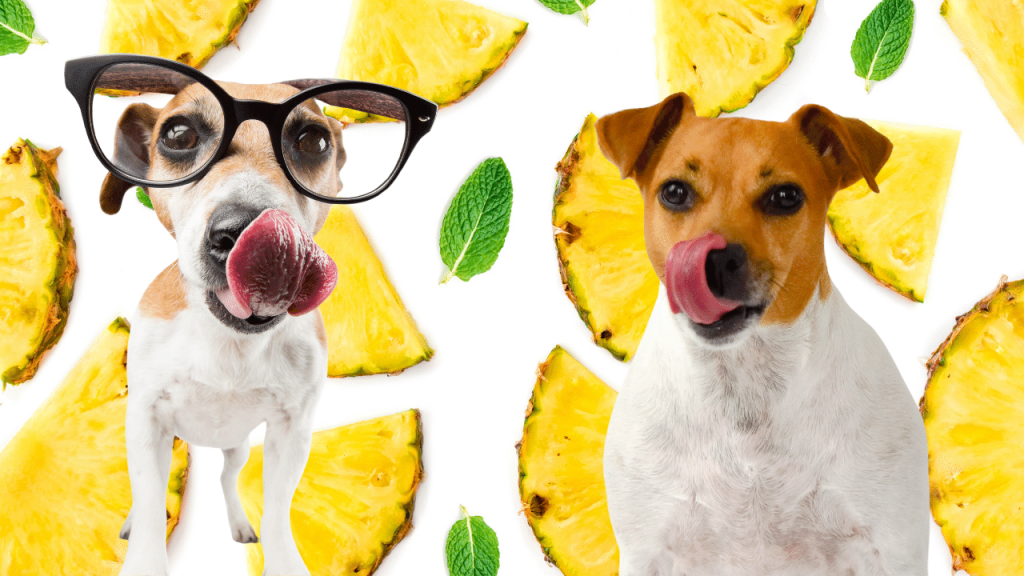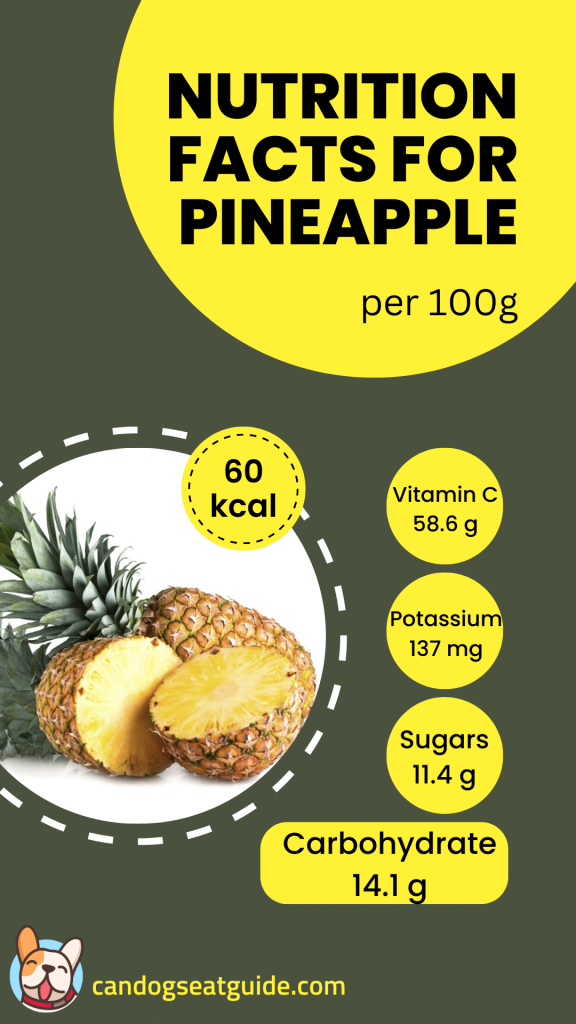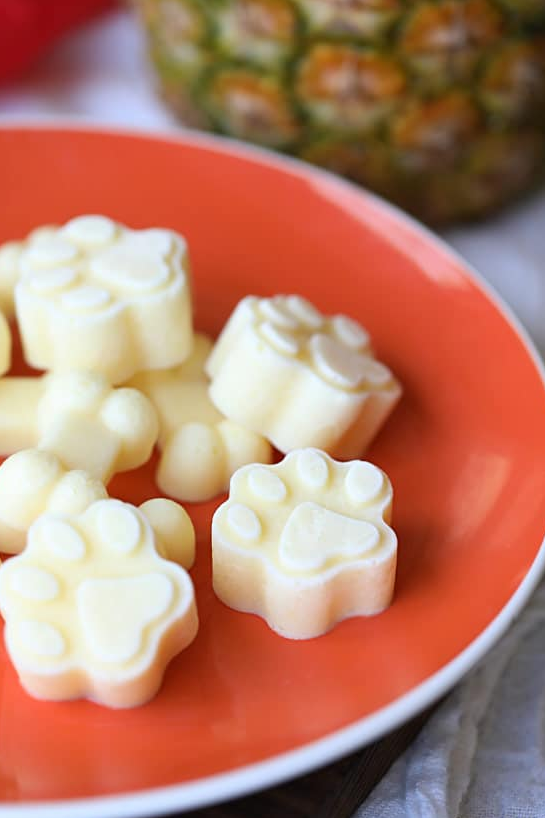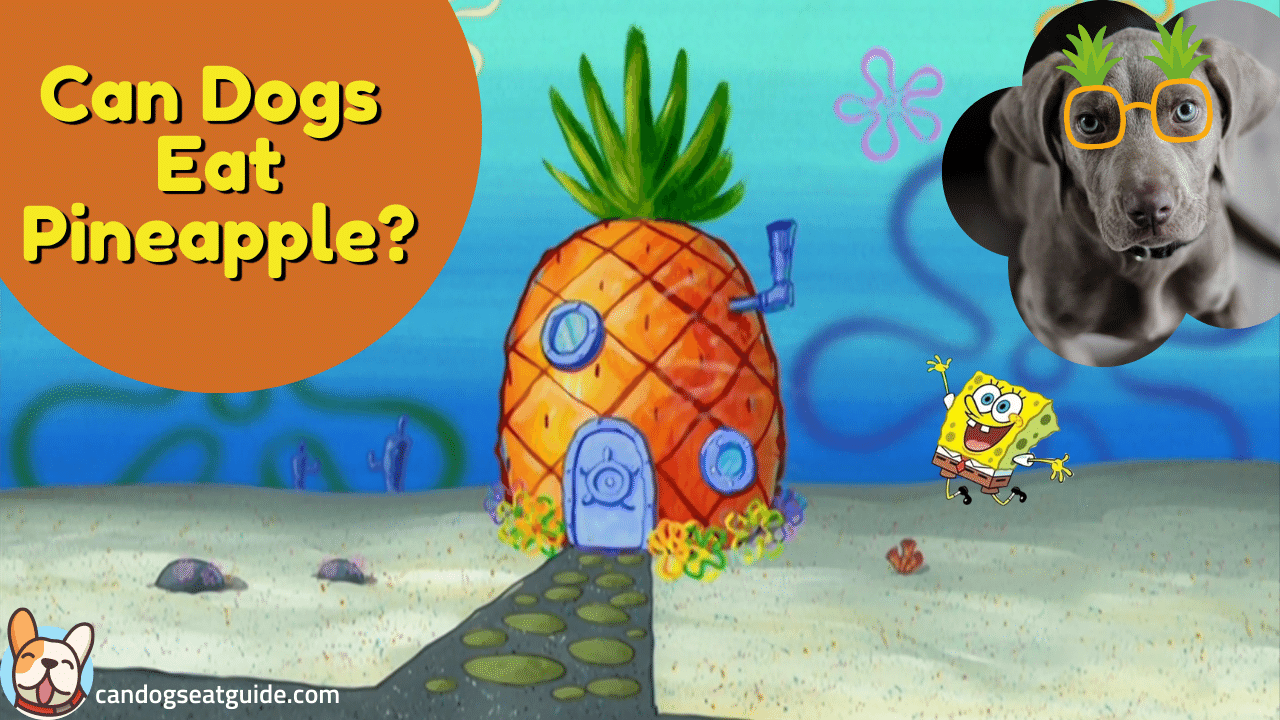Are you a fan of pineapple? I am asking you because I looove it. There are so many tasty drinks, salads, and sweet treats with pineapple.
If you were looking for an answer to the question “Can Dogs Eat Pineapple?”, then you are at the right place. Dogs can eat pineapple safely but as with every other human food in moderation.
Find all the nutrients and health benefits your dog will gain from eating sometimes pineapple and don’t forget to check the recipes at the end of the article.
Can Dogs Eat Pineapple?

Yes, dogs can eat pineapple as this delicious fruit is completely fine for the overall health condition of your dog. It’s not toxic fruit but like every other human food can be dangerous if it’s eaten in big amounts.
That’s why pineapple should be eaten in moderation. Dogs with sensitive stomachs shouldn’t eat pineapple as it can cause tummy problems.
Another reason is that although pineapple is full of vitamins and minerals, it also contains high levels of natural sugar. And it will be not good to be given to dogs that already have problems with diabetes.
The third reason why should give only small amounts of pineapple to your four-legged best friend is that the fiber content is in a pretty good amount and too much fiber can cause diarrhea. But don’t forget that dogs need fiber so they don’t get a bad form of constipation.
But all of that shouldn’t be worrying as soon as you don’t give half a pineapple to your dog, 2 slices are more than enough. As you should remember that human foods are only for treats, they shouldn’t be a meal for your dog.
Why Dogs Should Pineapple?
Yes, you would love to know that dogs can eat pineapple.
It’s full of vitamins like vitamin C, vitamin B6, vitamin B2 (known also as riboflavin), vitamin B1 (thiamine), vitamin B3 (niacin), and vitamin B9 (folate).
Pineapple is also full of minerals and some examples of these minerals are manganese, potassium, and iron.
These vitamins and minerals are a great source of nutrients for the immune and digestive systems of your dog.
But of course, a slice of pineapple can’t give your dog the needed vitamins and minerals but it’s a great addition to the right type of food and/or supplements it’s getting.
Nutritional Value of Pineapple
Around 85% of the pineapple is water so it is very good if you are living in a dry and hot area to treat your dog with this delicious fruit as a snack. It will help in keeping hydration and moisture in your dog on hot summer days.

The two types of antioxidants that are present in this fruit – flavonoids and phenolic acids – repair the damaged cells of your dog’s body. Also as you may know the main function of antioxidants is to fight the free radicals that are in your pooch.
Vitamin C plays its part in keeping the immune system in a better position and acts as an anti-inflammatory agent. Vitamin B6 is also present in pineapple to look after the body and brain functions, regulating hormones and building proteins.
The minerals are responsible for healthy skin, coat, and tissues.
After these positive sides let’s not forget that the amount should be strictly watched as there are 11.4 grams of sugar in 100 grams of pineapple.
How to Feed Pineapple to My Dog?
Dogs can eat pineapple in small quantities and let’s not be more than once a week. Pineapple should be cut in slices, be sure to remove the skin and core of the pineapple as they may cause obstructions, upset stomach, and diarrhea.
Another way of giving pineapple to our dog is in its frozen form. It’s a great treat for hot summer days.
Make sure no matter if raw or frozen, pineapples are cut into bite-sized pieces. Don’t forget to check for any strange symptoms after feeding your dog pineapple.
What to Look For In My Dog After Eating Pineapple?
It’s important no matter what type of food you give to your dog – human or dog food – to be careful for the next few hours how the body and digestive system of your dog will react to that new food.
If you give your dog pineapple for the first time then you should look for some of these signs as your dog may have some reaction towards it but that’s not often happening.

Signs of eating too much pineapple or reaction to pineapple:
- diarrhea
- upset stomach
- bloated abdomen
The sugar contents may upset the stomach if given in large amounts or often. So it is highly recommended pineapple be served in small slices once in a while.
How is Pineapple Unhealthy for Dogs?
There is no such thing as pineapple being unhealthy. But there are some types of dogs that will not be feeling good after eating pineapple.
Why? What do you mean? – you may ask.
The answer is here. Dogs that have weight problems, diabetes, or upset stomachs should avoid pineapple.
The first reason why these dogs should stay away from pineapple is that it contains sugar. Eating too much sugar isn’t good for any dog but you should be more careful about dogs with diabetes and obesity. As the extra sugar intake can cause some life-threatening situations.
The fiber that is present in this fruit may not react well for dogs with sensitive stomachs. But for completely healthy dogs fiber is good if of course given in the proper amount.
Can My Dog Eat Canned Pineapple?
Canned pineapple is safe for your dog but with no extra sugar added. The canned pineapple with extra added sugar can raise the blood sugar level, especially if your dog has diabetes. It is also very possible that the nutrients and enzymes get reduced during the canning process.
So that’s why it is always better to offer fresh pineapple. However, if you are left with no other option except canned pineapple, rinse it off with water before serving it to your dog. By rinsing canned pineapple, extra sugar will be removed and it will be a safe treat for your canine.
But I still highly recommend canned pineapple to be avoided.
Pineapple recipes for Dogs
Pineapple Dog Treats
Ingredients:
- 1/2 cup of frozen or fresh strawberries;
- 1/2 cup of frozen or fresh pineapple;
- 1/2 cup up to 1 cup of cold water;
- 1/4 tsp of coconut oil for each bone mold.
Method:
- If using fresh strawberries make sure they are clean and leaves/stems are removed. If using fresh pineapple make sure it is fully peeled and cored. Using already packaged frozen fruit makes this recipe extra easy.
- Put strawberries, pineapple, and 1/2-1 cup of water in your blender and puree until smooth. Start with 1/2 cup of water and add more until you achieve a smooth consistency.
- Using a teaspoon, gently pour the fruit mixture into each silicone mold until each mold is about 3/4 of the way full.
- Gently warm your coconut oil in a double boiler or microwave. Heat in 10-second increments if using a microwave.
- Freeze for at least two hours before serving it to your dog.
Pineapple Popsicles

Ingredients:
- 1 1/2 cups cubed fresh pineapple;
- 2/3 cup plain Greek yogurt.
Method:
- Place pineapple chunks in the bowl of a food processor and pulse several times until completely smooth and no pieces remain.
- Add in the yogurt and pulse several more times until incorporated. Don’t worry if your mixture is very liquidity – it should be like that.
- Transfer to a measuring cup with a spout so it’s easier for you when you should pour in the next step.
- Place molds onto a baking sheet. Fill the molds.
- Place in the freezer for about 3 hours or until solid.
- The delight is ready.
- Serve it to your puppy.
Some Fun Facts About Pineapple
- Pineapples regenerate! You can plant pineapple leaves to grow a new plant.
- Pineapples contain the bromelain enzyme which can break down proteins, so you can use them to tenderize meat.
- One pineapple plant can produce one pineapple at a time.
- Costa Rica grows around 75% of all pineapples sold in Europe.
- Pineapples can live and produce fruit for up to 50 years in the wild.
- The most expensive pineapple recorded was worth $12,800.
- The pineapple is made up of mostly water (86%) and carbohydrates (13%), with almost no fat or protein.
- Pineapples are a cluster of hundreds of fruitlets.
- The Dole Plantation Pineapple Garden Maze in Hawaii has the record for the largest maze in the world.

Conclusion
Pineapple is the perfect summer treat for your dog. It can eat it in its raw fresh form or frozen. A few pieces of pineapple are enough as it’s still a fruit and it has high sugar content.
It’s better to not give pineapple to dogs that have diabetes or upset stomachs.
Let us know in the comment section if you have ever given pineapple to your dog and if it was liked or not in the beginning. Also, you can share with us how you give pineapple to your dog – in its raw form or in some sweet treat?
FAQs
Can Dogs Eat Pineapple Skin?
Dogs shouldn’t eat the spiny skin of the pineapple as it may cause an upset stomach or obstructions.
Can Dogs Eat Pineapple Core?
Dogs mustn’t eat the core of pineapple as it can cause bowel obstructions – a blockage in the stomach or intestines.
Can Dogs Have Pineapple Juice?
Yes, dogs have pineapple juice but in very small amounts as the concentration of sugar is higher than from a fresh pineapple.
Can Dogs Have Canned Pineapple?
Canned fruits and veggies are advised to be avoided for dogs. The same is the case with pineapple, as canned pineapple contains very high levels of sugar in the syrup and it can cause digestive problems for your dog. But some vets suggest washing the slices with water and the sugar content will drop.
Can Dogs Eat Dried Pineapple?
As with every other dry fruit, pineapple’s sugar content is getting higher than in its raw form. Another reason why dried pineapple should be avoided is the extra calories that your dog doesn’t need, especially that have obesity or diabetes.








